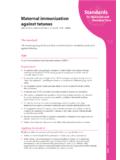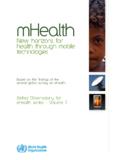Transcription of Making an Autism Spectrum Disorder Diagnosis
1 Making an Autism Spectrum Disorder DiagnosisEndorsed by the American Academy of Pediatrics and the Society of Developmental and Behavioral PediatricsDeveloped in partnership with Health Resources and Services Administration maternal and Child Health BureauMaking an Autism Spectrum Disorder DiagnosisAutism Case Training: A Developmental-Behavioral Pediatrics Curriculum1 Three Steps to Prepare - In 15 Minutes or Less! Read through the Facilitator s Guide and make copies of the case and learner worksheet for distribution. Identify the key topics you wish to address. Consider: Knowledge level of learners Available time Your familiarity with the subject Select and prepare the optional teaching tools you wish to use. Each case provides a variety of optional materials to enhance the learning environment, support facilitator style, focus on different themes, or accommodate different time limitations. These materials are optional for facilitators to use at their discretion.
2 Handouts: select any you wish to use and make copies for distribution PowerPoint: decide if you wish to use and confirm necessary technical equipment Video: review embedded video and video library, decide if you wish to use, confirm necessary technical equipment, and conduct test run 123 AbstractBilly is a 3 -year-old boy whose mother brings him to see you because of concerns about behavior problems at home and in school. After listening to the mother s concerns, observing Billy in your office, and reviewing his history, you refer Billy for a comprehensive evaluation for Autism Spectrum Disorder (ASD). You follow up with Billy s mother and with specialists involved in his evaluation to ensure the process is completed and to learn the GoalThe Diagnosis of Autism Spectrum Disorder (ASD) is made on the basis of detailed information obtained from the child s caregivers, careful observation and assessment of the child, and the use of standardized tools designed to aid in the Diagnosis of ASD.
3 After completion of this module , learners will be able to:1. Be familiar with the basic principles regarding the Diagnosis and epidemiology of Understand the diagnostic approach to evaluating a child with suspected following case was developed by the authors. It does not necessarily reflect the views or policies of the Department of Health and Human Services (HHS) or the Centers for Disease Control and Prevention (CDC).Developed in partnership with Health Resources and Services Administration maternal and Child Health an Autism Spectrum Disorder DiagnosisAutism Case Training: A Developmental-Behavioral Pediatrics Curriculum2 Key Learning Objectives of This Case1. Be familiar with the basic principles regarding the Diagnosis and epidemiology of Describe the two primary areas of impairment in ASD and the severity rating system. (Prompt and Handout IV: DSM-5 Diagnostic Criteria for ASD)b. Know the currently reported estimate of the prevalence of ASD in the (Prompt )c.
4 Describe the current evidence for the genetic etiology of ASD. (Prompts and ) 2. Understand the diagnostic approach to evaluating a child with a suspected Identify the important elements of a comprehensive history. (Prompts and )b. Recognize the important features to assess when observing a child s List the aspects of the physical exam that are of particular importance when evaluating for ASD. (Prompt )d. Describe the components of a comprehensive diagnostic evaluation for ASD. (Prompt and Handout I: Components of a Comprehensive Evaluation for ASD)Only Have 30 Minutes to Teach? Focus your discussion on principles of Diagnosis and the diagnostic approach. Use: Handout I: Components of a Comprehensive Evaluation for ASD and Handout IV: DSM-5 Diagnostic Criteria for ASD Potential Prompts: , , , and Provided Case Worksheet for Learners The Case Study: Part I, II, III, IV, V (available in Facilitator s Guide and on CD) Optional Teaching Tools- PowerPoint with Embedded Videos (available on CD)- Handouts (available in Facilitator s Guide and on CD) Handout I: Components of a Comprehensive Evaluation for ASD Handout II: Differential Diagnosis of Autism Spectrum Disorder Handout III: AAP screening guidelines Handout IV: DSM-5 ASD Checklist Handout V: Fragile X Syndrome Fact Sheet- Video Library (available on CD) ReferencesCase AuthorsKimberly Macferran, MD, University of Arkansas for Medical SciencesNili Major, MD, Albert Einstein College of Medicine, Children s Hospital Montefiore: Yale University School of MedicineJill J.
5 Fussell, MD, University of Arkansas for Medical SciencesPamela High, MD, Warren Alpert Medical School of Brown UniversityEditorsGeorgia Peacock, MD, MPH, National Center on Birth Defects and Developmental Disabilities, Centers for Disease Control and PreventionCarol Weitzman, MD, Yale University School of MedicineCatherine Rice, PhD, National Center on Birth Defects and Developmental Disabilities, Centers for Disease Control and PreventionJana Thomas, MPA, Porter NovelliWendy Ruben, MS, Porter NovelliJulia Whitney, Carter Consulting, Inc., National Center on Birth Defects and Developmental Disabilities, Centers for Disease Control and Prevention :30 Making an Autism Spectrum Disorder DiagnosisAutism Case Training: A Developmental-Behavioral Pediatrics Curriculum3 Getting StartedThis case is designed to be an interactive discussion of a scenario residents may encounter in their practice. Participation and discussion are essential to a complete learning experience.
6 This Facilitator s Guide provides potential prompts, suggestions for directing the discussion, and ideas for incorporating the optional teaching tools. It is not designed as a study icons: Call-out: step-by-step teaching instructions Note: tips and clarification Slide: optional slide, if using PowerPoint Filmstrip: optional slide contains an embedded video Paper: potential place to distribute an optional handout :30 Digital clock: tips if you only have 30 Minutes to Teach Why is This Case Important?It is important for parents to understand that there is no specific lab test or procedure to diagnose ASD. Rather, the Diagnosis is made on the basis of detailed information obtained from the child s caregivers, careful observation of the child, and the use of standardized tools specifically designed to help diagnose ASD. The Diagnosis may be made by a clinician who has expertise in the Diagnosis of ASD or by a team of specialists that may include developmental-behavioral pediatricians, child neurologists, child psychiatrists, psychologists, speech-language pathologists, occupational or physical therapists, educators, and social the session goal and format of the case studySlide 1-2 Cultural CompetenceIt is important for clinicians to understand how different childrearing practices and cultural norms may influence key decisions that parents make regarding their child, including obtaining evaluations and treatment, future planning, and acceptance of the child s Diagnosis .
7 Clinicians can approach parents openly and honestly by asking them about their unique style of parenting and how the information or recommendations provided are the curriculum introduction for additional information on cultural competence and potential discussion an Autism Spectrum Disorder DiagnosisAutism Case Training: A Developmental-Behavioral Pediatrics Curriculum4 Distribute Case Study Part ISlide 3 Case Study Part IBilly is a 3 -year-old boy you are seeing for the first time in your resident practice. He was born full term following a normal pregnancy and delivery. His newborn screen and neonatal hearing test were normal. At 18 months, he underwent bilateral myringotomy tube placement following repeated bouts of otitis media. His mother also had concerns that he was not speaking any words, and his doctor said, Let s wait and see. A follow-up appointment was scheduled for when he turned 2. At his 2-year well-child check, because of the history of global developmental delay, he was referred to early intervention (EI) months ago, Billy began attending a specialized preschool in the local school district; there, he receives speech, physical, and occupational therapies.
8 This is the third preschool Billy has attended. He was asked to leave his previous schools because of behavioral problems. Billy s mother reports that his current preschool teacher recommended that she take him to the pediatrician given concerns about his behavior. Since he began preschool, his teachers have reported that he is extremely hyperactive, does not follow directions, and largely ignores the children in the s mother reports that he has been in good health recently. She tells you that all of his milestones were delayed, particularly his language. She denies any history of developmental regression. She adds that Billy has made some nice progress since he began receiving EI services. He will now use single words like juice and cookie to make requests. At home, Billy is a handful, but he will usually calm down when she turns on his favorite cartoon. She describes him as a sweet and loving boy, but she also shares that he will have prolonged tantrums when denied what he wants and that tantrums will often occur when they are attempting to leave their house.
9 During these tantrums, he will frequently bang his head and bite his hand, which frightens her. For some time now she has been concerned that Billy does not like to play with his similar-aged cousins during family get-togethers, but she thought this was because he was an only child and didn t like to share. She had been eagerly awaiting his first day of preschool so that he could spend more time around other asked about family history, Billy s mother reports that her sister s 7-year-old son is in special education, but she is not sure what kind of evaluation has been done as her sister does not like to talk about these kinds of things. She mentions that it has been hard for the family, and she finds Billy s preschool reports to be embarrassing and discouraging. She is frustrated and wants the best for an Autism Spectrum Disorder DiagnosisAutism Case Training: A Developmental-Behavioral Pediatrics Curriculum4 Distribute Case Study Part ISlide 3 Case Study Part IBilly is a 3 -year-old boy you are seeing for the first time in your resident practice.
10 He was born full term following a normal pregnancy and delivery. His newborn screen and neonatal hearing test were normal. At 18 months, he underwent bilateral myringotomy tube placement following repeated bouts of otitis media. His mother also had concerns that he was not speaking any words, and his doctor said, Let s wait and see. A follow-up appointment was scheduled for when he turned 2. At his 2-year well-child check, because of the history of global developmental delay, he was referred to early intervention (EI) months ago, Billy began attending a specialized preschool in the local school district; there, he receives speech, physical, and occupational therapies. This is the third preschool Billy has attended. He was asked to leave his previous schools because of behavioral problems. Billy s mother reports that his current preschool teacher recommended that she take him to the pediatrician given concerns about his behavior.













